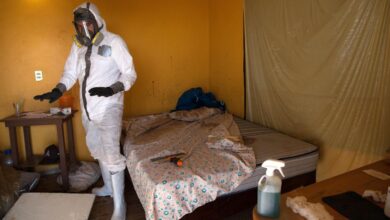What is the monkeypox virus and how do you catch it?

Introduction:
Monkeypox is a rare viral infection. It’s similar to smallpox but much less infectious and, while it can be fatal, there are normally fewer fatalities. This week, the UK’s first case of the virus was confirmed in Cornwall. The patient is believed to have contracted the disease while visiting Nigeria before traveling home to the UK. But how do you catch monkeypox? And what are its symptoms?
Monkeypox first emerged in west and central Africa in the 1970s.
- monkeypox first emerged in west and central Africa in the 1970s.
- It is believed that a virus related to monkeypox was circulating among wild animals for many years before scientists discovered it. In 1970, monkeys infected with a new strain of poxvirus were found in Kinshasa, the capital city of the Democratic Republic of Congo (DRC).
- In humans, monkeypox causes an illness similar to smallpox but less severe, with a mortality rate between 1% and 3%.
The condition, which is a rare viral infection, shares some characteristics with both smallpox and the chickenpox virus.
Monkeypox is a rare viral infection that shares some characteristics with both smallpox and chickenpox. It is usually more common in Africa, but cases have been reported in other parts of the world as well.
How it’s spread
The disease can be spread through direct contact with infected animals or humans. You cannot get it by breathing the same air as someone who has monkeypox or by touching objects such as clothes, bedding, or food contaminated by someone with monkeypox. The virus doesn’t seem to spread easily from one person to another. But some patients report getting the infection after sharing things like utensils, cigarettes, and food with other infected people.
It’s not yet clear whether there are any long-term health consequences of having monkeypox — whether you always need treatment for it or if your immune system will eventually fight off the illness on its own
Monkeypox is passed on through direct contact with an infected animal or human, but catching it from infected animals appears to be far more common than direct human-to-human transmission.
Monkeypox is a rare viral infection that can be spread from animals to humans and from humans to humans. It’s not easily transmitted between humans, however, and it seems most common for infections to occur after contact with infected animals.
The virus primarily affects monkeys but has also been found in other mammals such as rodents, bats, cats, and dogs. The disease has been reported in Africa; Central and Southern America; West Africa; Congo Basin countries (including Gabon); Nigeria; Ivory Coast; Ghana; Burkina Faso (formerly Upper Volta); Mali; Senegal and Togo.
Illnesses have been reported in two types of African rodents before, but scientists think the original reservoir for monkeypox transmission was probably tree squirrels.
One of the more interesting theories about the origins of monkeypox is that it was first transmitted from African rodents to humans. The most likely reservoir for transmission is tree squirrels, which are thought to have been infected with the virus in Africa and brought it to the United States through pet trade or travel.
While there is no evidence that these viruses can be transmitted between humans, they are found in a wide range of animals that may come into contact with people. It has been suggested that any animal could act as a host for smallpox-like viruses and other related pathogens, leading to human infection when they come into contact with humans.
A case study published in 2006 describes how two men who were taken into quarantine after being exposed to an infected squirrel developed symptoms consistent with smallpox within five days. DNA tests on both patients showed strong evidence that they had contracted monkeypox from their exposure; however no other cases appeared among others who shared their hospital room during this time period despite sharing a similar route of exposure (i.e., being bitten by an infected squirrel).
Scientists are still trying to work out how exactly humans become infected with the disease. The most likely possibility is that a bite from a rodent passes on the virus.
Scientists are still trying to work out how exactly humans become infected with the disease. The most likely possibility is that a bite from a rodent passes on the virus.
If you do get monkeypox, it’s very likely that you’ll develop mild symptoms—this usually means a few small, red bumps on your skin that don’t itch or hurt, and last anywhere between one to three weeks before disappearing. But in some cases, monkeypox can cause more severe symptoms such as fever, vomiting, and chest pain; this happens in less than 1% of cases and looks like measles or chickenpox (but without all those spots).
Monkeypox can also spread internally to organs like your kidneys or liver and cause long-term complications such as arthritis, blindness, or even death in some rare cases if left untreated; these complications tend not to happen until after recovery from the initial infection has begun.
Monkeypox treatment is tricky because there isn’t much information about how best to treat it (though some doctors seem to think antibiotics may help), but treatments for viral diseases like chickenpox should work just fine for monkeypox too!
Symptoms typically appear five to 21 days following infection, with most cases appearing around 10 days after exposure.
Symptoms typically appear five to 21 days after infection, with most cases appearing around 10 days after exposure. Symptoms include fever, headache, muscle aches, backache, swollen lymph nodes, and chills. A few days after the first symptoms appear a rash develops.
The rash usually starts on one side of the body and it spreads over time to other parts of the body including arms and legs. The rash may be flat or raised red bumps that look like pimples or blisters filled with fluid; it can also resemble tiny chickenpox blisters but is only found on certain parts of your body (face or mucous membranes).
The illness lasts about four to seven days in adults but can last longer in children who are younger than age 5 years old because they have not yet built up immunity from previous exposures like older adults would have developed by this point in their lives
According to the World Health Organization (WHO), symptoms can include fever, headache, muscle aches, backache, swollen lymph nodes, chills, and exhaustion.
- According to the World Health Organization (WHO), symptoms can include fever, headache, muscle aches, backache, swollen lymph nodes, chills, and exhaustion. They’re similar to those of smallpox and chickenpox — as well as measles, mumps and rubella — but they tend to be milder. If you have smallpox or chickenpox-like symptoms during your travels abroad (or just don’t know whether you’ve been vaccinated for either virus), see a doctor immediately.
A few days after the first symptoms appear a rash develops – this can affect anywhere on the body, including the palms of hands and soles of feet.
A few days after the first symptoms appear a rash develops – this can affect anywhere on the body, including the palms of hands and soles of feet.
The rash is usually red in color and flat with scaly skin. The scaly skin may also be itchy or painful but it’s not always noticed by people who have monkeypox.
It is important to know when you might contract monkeypox and what to do if you suspect you have it
- If you think you have monkeypox, contact your healthcare provider.
- If someone in your family has been exposed to monkeypox and they are sick with a fever, call the doctor right away.
- Wash your hands frequently with soap and water or use an alcohol-based hand sanitizer if soap and water are not available.
Conclusion
Research indicates that monkeypox virus infections are rare, but when they do appear, it’s best to be prepared with information. The symptoms of monkeypox are similar to those of chickenpox, however, they can last longer and be more severe. It is important to seek medical attention if you suspect you have this disease and to avoid contact with anyone else who may also have been infected.







